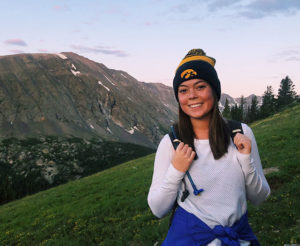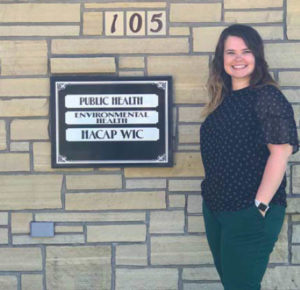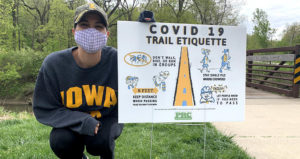This story originally appeared in the spring 2020 issue of InSight.
Breadcrumb
Pandemic 101: Real-world lessons for public health students
Published on August 26, 2020
The novel coronavirus is providing public health students with unique learning opportunities
Just a few months ago, lectures about the 1854 London cholera outbreak or the 1918 Spanish flu pandemic might have seemed like ancient history to students. Now, as the world confronts unprecedented challenges associated with the COVID-19 pandemic, public health students are witnessing—and actively participating in—an extraordinary moment in their chosen field of study.

For Jessica Allen, a junior majoring in public health, her spring 2020 internship at the Johnson County Public Health Department provided an insider’s view into the early days of the novel coronavirus pandemic in Iowa.
“I’ve been able to watch this virus grow from an outbreak in China to a global pandemic to eventually a local emergency,” Allen says. She assisted her internship supervisor on COVID-19-related projects during the county’s preparedness stages, including creating documents that were sent to people being monitored for COVID-19.
In March, the pandemic prompted the University of Iowa to close much of campus and move to virtual classes, meaning Allen’s internship also had to switch gears.
“After spring break, I had to finish my internship from home in West Des Moines,” Allen says, She completed a vaccine policy project, “but I wish I could have been able to witness more on how county public health departments handle pandemics,” she says.
Public Health in Action

Kaci Ginn, a second-year undergraduate public health student, was able to work on-site for her internship with Jones County Public Health in Anamosa, Iowa. Ginn worked with the public health department in coordination with emergency management and other community and state partners to plan and coordinate the county’s response to COVID-19. Her duties ranged from assisting with contact tracing and disease follow-up to communications and social media coordination.
“Being able to incorporate what I’m learning about public health emergency preparedness as well as coordinating public health’s response with the emergency manager in the county has been an amazing opportunity to see the greater reach of public health activities in practice,” Ginn says.
Experiencing classroom lessons being translated into real-life actions has made an impact on Allen as well.
“I believe this pandemic has cemented my decision about being a public health major,” Allen says. “Not only have I been able to see firsthand all of the public health information I’ve learned in college being put to use in the world, but I’m also able to explain to my family what is going on in a way that they can understand.”
Crafting Communications
As the pandemic unfolded in early March, UI administration asked the College of Public Health to help develop an awareness campaign about the importance of social distancing. A group of CPH students and faculty, including Elizabeth Chrischilles, Jim Torner, Maggie Chorazy, Natoshia Askelson, and Ryan Carnahan, led by Rima Afifi, professor and head of community and behavioral health, crafted a series of evidence-based messages that were distributed through university social media channels. Several CPH students also spearheaded the creation of a university web page that lists resources for emergency housing, food, financial, and mental health assistance for students and others in the campus community.
Another group of CPH students produced a series of podcasts about COVID-19, interviewing experts on topics such as preparedness, exposure risks, protective measures, disease modeling, telehealth, and more. The podcast, From the Front Row, was recently recognized as one of the 30 best public health podcasts for 2020 by MPH Online.
Coronavirus in the Curriculum
Not surprisingly, faculty incorporated COVID-19 into the semester’s coursework. Undergraduates in the class Global Public Health, taught by Kelly Baker, assistant professor of occupational and environmental health, learned about the global burden of respiratory infections and how they spread or can be prevented; how diseases emerge and the role of animals in outbreaks; and the role of social behavior and environment in pathogen spread. Students also worked on group projects to design interventions to prevent COVID-19 in refugee camps.
Renée Anthony, professor of occupational and environmental health, teaches the graduate course Occupational Safety. As part of their coursework, students normally consult on-site with local small businesses and provide recommendations on fire safety, hearing protection, and trip and fall hazards. This spring, the class had to quickly adapt as many area employers shut down normal business activities and the university moved to online classes.
“We had to think creatively and changed the class projects to focus on developing safety recommendations and materials for people working at home,” says Anthony.
Laura Tvedte, a master’s student in the industrial hygiene program, completed the Occupational Safety class from her hometown of West Branch, Iowa. Taking classes remotely gave Tvedte insight into some of the issues of working from home.
“Not having a proper work station setup is a challenge for me, and it’s difficult to not see people and be socially isolated,” she says. “These are some of the areas that our team addressed, along with chemical safety, electrical safety, and helping essential workers.”
The class solicited questions and concerns from employees working at home and created a website with safety materials, ergonomic tips, and more.
Keeping Your Distance
As states ease restrictions and “quarantine fatigue” sets in, the need for physical distancing and other precautions remains, even in the great outdoors.

Anne Abbott, a PhD student in community and behavioral health, collaborated with local parks and recreation departments to produce materials that build awareness of social distancing etiquette while using outdoor public spaces. The materials are free and available for anyone to download.
“This project focuses on specific ways that individuals can socially distance while they are using outdoor spaces like parks, trails, and sidewalks,” Abbott explains. “A group of students and others from the college reviewed the research on how respiratory viruses spread, developed the messages, and worked with a designer to create the materials.”
Abbott says the response to the signs and social media images has been positive.
“So far it’s been great! We’ve had a lot of statewide groups tell us how thankful they are for the materials and how much they think they are needed,” she says. Going forward, Abbott hopes to gather formal feedback and conduct a basic evaluation of the project.
A New Awareness
While the devastating impact of the COVID-19 pandemic is far reaching and much remains uncertain, Allen, who will enter her senior year in the fall, hopes the crisis sparks a new awareness of public health.
“I heard this phrase one time, ‘No one knows what public health is until we need it,’ and that is very true,” she says. “I hope this pandemic has opened the public’s eyes about the importance of public health and how vital it is to plan and provide funding for emergency preparedness for the sake of all of our health and safety.”
“In times of crisis, systems that have been weakened from years of neglect or lack of funding can begin to break down,” Ginn adds. “As we work through this pandemic, interventions must be considered in terms of complete systems in order to support entire communities.”
Also check out this CPH student podcast that features College of Public Health students discussing their work as contact tracers with departments of public health in the fight against COVID-19.